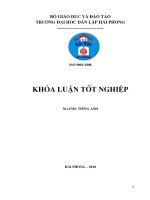- Trang chủ >>
- Mầm non >>
- Mẫu giáo nhỡ
On the stability of the distribution function of the composed random variables by their index random variable by their index rando
Bạn đang xem bản rút gọn của tài liệu. Xem và tải ngay bản đầy đủ của tài liệu tại đây (894.67 KB, 6 trang )
<span class='text_page_counter'>(1)</span><div class='page_container' data-page=1>
VNU Journal o f Science, M athem atics - Physics 23 (2007) 70-75
On the stability of the distribution íunction of the composed
random variables by their index random variable
Nguyen Huu Bao*
<i>Facuỉtỵ o f Infom aíion Technology, Water Resources U niversity </i>
<i>ì 75 Tay Son, D ong Da, Hanoi, Vietnam</i>
Received 15 November 2006; received in revised form 2 August 2007
A b s t r a c t. Let us consider the composed random variable <i>T Ị</i> = <i>Y lk =</i>1&> vvhere —
are independent iđentically distributed random variables and <i>V</i> is a positivc value random,
independent of all
In [1] and [2], we gave some the stabilities of the distribution function of <i>7]</i> in the following
sense: the small changes in the distribution íunction of <i>Ẹk</i> only lcad to the small changes in
the distribution íunction of <i>TỊ.</i>
In the paper, we investigate the distribution íunction of <i>TỊ</i> vvhen we have the small changes of
the distribution of <i>V.</i>
1. Introduction
Lct us consiđcr the random variable (r.v):
<i>v =</i> (
<sub>1</sub>
)fc=i
where ^
1
,^2
) ••• are inđependent identically distributed random variables vvith thc distribution function<i>F(x), V</i> is a p o s i t i v e v a l u e r.v i n d e p e n d e n t o f a l l <i>ịk</i> a n d <i>V</i> h a s t h e d i s t r i b u t i o n f u n c t i o n A ( x ) .
In [1] and [2], 7? is called to be the composed r.v and <i>V</i> is called to be its indcx r.v. If ^ ( x ) is
the distribution function o f <i>TỊ</i> w ith the characteristic function <i>xị> (x )</i> respecrively then (see [1] or [2])
<i>Ip{ x) =</i><b> a[v?(í)] </b> <b>(2 )</b>
<i>w here a ( z ) is the generating function o f V and <p(t) is the characteristic íunction o f </i>
tk-In [
1
] and [2
], vve gave some the stabilities of in the íollovving sence: the small changesin the distribution function <i>F ( x )</i> only lead to the small changes in the distribution íunction 't(x).
In this paper, we shall investigate the stability of <i>T)'s</i> distribution function vvhen we have the
small change of the distribution of t h e indcx r.v <i>V .</i>
Tcl.: 84-4-5634255.
E-maiỉ:
</div>
<span class='text_page_counter'>(2)</span><div class='page_container' data-page=2>
<i>Nguyen Huu Dao / VNU Journal o f Science, Malhematics</i> - <i>Physics 23 (2007) 70’ 75</i> 71
2. Stability theorem
Let us consider the r.v now:
<i>V</i>
1
(3)
<i>ỵ \</i>
<i>m = Ỳ , Z k </i>
<i>k=</i>
1
vvhcre <i>ư\</i> has the distribution function i4i(x) with the generating íimction ai(^). Suppose £* have the
stable lavv vvith the characteristic function
y > ( í ) = e x p<i>{ i n t</i> - c | í | “ [ l - < * ) ] } ( 4 )
where c, <i>ụ., a, Í3</i> are real number, c >
0
; <i>\0\</i> ^1
,<i>Ctt</i>
2 > <i>a ></i> Qi > 1; <i>U)(t\a</i>) = <i>t g ~ .</i> (5)
<i>Lđ</i>
For cvery <i>£</i> > 0 is given, such that
£<<é>3
'6>
vvhere c
2
= (c + <i>c \8 \\tg ^ Y ~</i> + ImD-We have the following thẽorem:
Thcorem 2.1 (Stability Theorem). <i>Assume that</i>
<i>p ( A\ Ai ) =</i> sup |>l(ar) - v4j(x)| ^ <i>£</i>
<i>x<éR'</i>
<i>n ' \ = ị </i> <i>z a d A ( z</i>) < +00; — <i>[ z a d A i ( z</i>) < +00, Va > 0. (7)
<i>J</i>0 <i>J</i>0
<i>Then</i> vve <i>have</i>
<i>where K \ is a constant Ỉndependenỉ o f e,</i> ^(x) <i>and t yi i x) ơre the distribution/unction o f T) and 7]\ </i>
<i>respectively.</i>
Lcnima 2.1. <i>Let a is ơ complex number, a</i> = pelớ, <i>such that</i> |ỡ| ^ 0 ^ <i>p</i> ^ 1. <i>Then xve have íhe</i>
<i>foIlowing estimaỉion:</i>
|a
4
—1
| ^ ~ II <i>(Ị o r e v e r y t ></i>0
) (8
)(1 - <i>\ a -</i> 1|)
<i>Proof.</i> Sincc <i>a — p(cos9</i> + isinớ), it follows that <i>al = pl (costd</i> + ỉsintớ).
Hence
|aí - 1
|2
= (<i>p l</i> cos <i>to</i> — l)2
+ <i>(pl</i> sin <i>tô)2,</i> (9)we also have
<i>( p ‘ cos t O</i> - 1) = (p1 - l) c o s íớ + (cosíớ - 1),
Notice that |1 — co sx | < |x| for all <i>X,</i> thus
1/9‘ cosíớ — 1| < I<i>p l</i> — 1| + <i></i>
\t0\-On the other hand, since I sin u| ^ |tt| for all <i>u,</i>
</div>
<span class='text_page_counter'>(3)</span><div class='page_container' data-page=3>
72 <i>Nguyen Huu Bao / VNU Journaỉ o f Science, Mathemalics</i> - <i>Physics 23 (2007) 70-75</i>
vve can sce
|o —
1|2
= <i>( p</i>cosớ - l)2
+ (p2
sin2
ớ).lt follows that
1/9sinớ| < |a - 1|. (11)
Furthermore,
<b>||a | - 1| < |a - lị =» |p - 1| < |a - 1| => p > 1 - |a - 1|.</b>
From (
11
) we obtain|sto#Kllzii<_fezỊL.
(12)
Since |ớ| ^ ^ => I sin ỚỊ > — , so that
" 3>
From (10) and (13), we have
0 4 ,
For all <i>t</i> > 0, the íbllovving inequality holds:
Using (11) and notice that |1 - <i>p\</i> = |1 — <i>\a\\</i> < |a - 1|, wc shall have
(16)
<i>p</i>
Hence by (14) we gct
la1 II2 - *4*2!0 ' ! ! !
-1
11
^(1
- | a -1
|)2
*Lcmma 2.2. <i>Under the notation in</i> (2), <i>let</i> ố(£) <i>be suỊỊìcienlly sm allpostive number such that</i> <5(é:) —> 0
<i>when e</i> —*
0
<i>and</i>l « w ( t ) l <
3v *>
1*1 < % ) •
<i>Then</i>
|ự»(í) <i>-ĩỉ>ị(t)\</i> ^ <i>c \ t \</i> Ví, |í| < ố(e)
<i>where c is a constant independenl o f e and \Ị)\ (t) is the characíeristic j\unciion with the distribution </i>
<i>/unction </i> <i>respecíively.</i>
<i>Proof.</i> We havc
<i>\ m - M t ) \ = \ r ° ° \ m</i> <i>zd ị A ( z ) - M z ) } \ $ f +e° \ ' p t ( t ) - l \ d [ A ( z ) + A l (z)].</i> (17)
<i>J</i>
0
<i>J</i>0
Notice that, for all <i>t</i> € <i>R ]</i>
<i>eitx</i> - 1 K 3 |sin (y )| ^ <i>ị \ t x \ < 2\tx\.</i>
Hence, if vvc put
<i>PF</i> = <i>[ </i> <i>\ x\ dF( x)</i> < +oo; <i><p(t)</i> = <i>í </i> <i>eitxd F ( x ) , </i>
</div>
<span class='text_page_counter'>(4)</span><div class='page_container' data-page=4>
<i>Nguyen Huu Bao</i> / <i>VNU Journal o f Science. Malhematics - Physics 23 (2007) 70-75</i> 73
then
M 0 - 1 K <i>j \eitx - l \ d F < 2\t\fiF.</i>
From Icmma 2.1, (with <i>a</i> = <p(í)ĩ M ^ ^(ê))
(18)
Because there exits moments (from (7)) and with í, |í| < <i>S(e)</i> we can see |1 — <i>ip(t</i>)I ^ therefore
i-r
W 0 - * ( 0 I < “ ( I ? t w >- I | ) <i|' 4 (z) + ‘4 , w l 4 <i>4 'y ĩ ĩ f ‘ r í l ‘ A + </i> )!i| = C |í|
(do |<^(í) -
1
| ^ /ìf|í| Ví)vvhere
<i>c</i>
is a constant independent of £ and <i>\x\(ỈF(x)</i> <00
.Proơ/ o/ <i>Theorem 2.1.</i>
For every <i>N</i> > 0 and <i>t</i> € / ỉ 1, we have
Ỉ ) -
<sub>1</sub>
M<sub>0</sub>
I = | <i>r s m</i> <i>A</i> <i>U</i> <i>- M</i> <i>m</i><i>J</i> 0
< I <i>í</i> v>*(í)<i[i4(z)-iM *)]| + l <i>r ° ^ m M z ) - A i ( z ) ) \</i>
<i>J</i>
0
<i>< |[M(í) - i4,(z)]|J, | + r M(z) - </i> <i>ln?(f)ldz + r ° ° d ị A ( z ) + *,(»)]</i>
.//V
= /ị +
/2
+ ^3- (19)First, it casy to see that
/1 ^ <i>2e. </i> (20)
In order to estimate /2, notice that y?(£) has form (4) vvith the condition (5) so vvc have
I ln ^ O I ^ <i>\ti\\t\</i> + |C (c + <i>c m t g ™</i> I) < <i>\fi\\t\ + C\</i> |*r (21)
wherc <i>Ci = c + c \ 0 \ \ t g ^ - \</i> < c + c|/?||Ỉ
5
^y-|.If <i>T = T( e)</i> is a positive number which vvill be chosen later (T(e) —* oo when <i>e</i> —* 0), we can see
that
I ln<p(í)| ^ I<i>ụ \T</i> + CiTQ < (Ci + lul)Ta ^ <i>C2T a</i> Ví, |í| ^ T(e)
vvhere c
2
= c + <i>c \ 0 \ \ t g ^ ~ \</i> + <i>\n\-,</i> (a > ữ] >1
).Then
/■*
/ 2 < £ / c 2r ° d z < <i>C2eTaN.</i> (22)
<i>J</i><b> 0</b>
Finally, vvith Q from condition (5), we have
(23)
By using (19), (20), (21), (23), we conclude that
</div>
<span class='text_page_counter'>(5)</span><div class='page_container' data-page=5>
74 <i>Nguven Huu Bao</i> / <i>VNU Journal o f Science, Malhemalics - Physics 23 (2007) 70-75</i>
_Ị_ J_
Choosing <i>T</i> = <i>£</i> <b>3 “ </b> and <i>N = T = e</i> 3rt, we can see tliat
1 1
1
<i>C2e T a N</i> <
<i>c2£l~</i>
3"3 = C2£-3,Thus
1
<i>(m a +</i> râ i <i>) N a = {ụ.aA</i> + )e3 .
ỉ
I
I
< 2 e + c 2£3 + 0 £ + r â , ) e 3 = c 3£3
<b>_Ị_</b>
for every í with |í| < T = £ 3“ and C
3
is a constant independent of5
.For all <i>S(s)</i> > 0, we consider novv
<i>r T</i> | v W Z J £ Ị Ơ<i>) Ịdl =</i> | V’ ( ' ) - y - ' ( ' ) |d t + <i>[</i> i ỵ W - j g i W | <a ,
J - T <i>t </i> <i>J-S(e) </i> <i>t </i> <i>J 5 (e )< \tK T </i> <i>i</i>
<b>Since</b>
lnz = ln |z| + <i>iarq{z)</i>
(0
^ <i>a r g z</i> ^ <i>2ir), </i>for all complex number <i>z,</i> letting
2
(|t| < ố(é:))<i>\o-rg<p(t)\ < |lny>(t)| ^ c 26{e)</i>
1 1
with ổ(e) = e3, we shall gct <i>\ argy{t)\</i> ^ C
2^3
and from (6
)1
< <i>n.</i> =►<i>\orgip{t)\</i> < ^ for every <i>t,</i> |f| < <i>Se.</i>
*J
0
Mcnce, using lemma
<sub>2</sub>
.<sub>2</sub>
, we obtain:<i>■S(e)</i>
On the other hand, using (25), we gct
<i>Ị</i>
|
<i><p(t) </i><i>M t ) ịdt</i>
Ơ3CỈ <i>í ' </i><i>ẹ =</i>
C j£ 3ln
<i>J - = c 3e3</i>N - r ^ ) <
c.,é7ổ(£)^|í|^T <i>t </i> <i>Jỗ(e) t </i> <i>ÒKe)</i> 1 7
£ 3a
From (26) and (27)
<i>r T</i> |v?(0 ỵ i ( 0 |rft ^ 2Ce3 + c 4eẽ < C5eC
7 - r
í
where C
5
is constant indcpcndent of <i>£.</i>Indccd, by using Esscn’s inequality (see [3]) we have
1
1
1
^ C 5e 6 <i>+ c 6e* ^ K xe</i>6
</div>
<span class='text_page_counter'>(6)</span><div class='page_container' data-page=6>
<i>Nguyên Huu Dao / VNU Journuỉ o f Science, Mathematics</i> - <i>Physics 23 (2007) 70-75</i> 75
Acknowledgcments. This papcr is bascd on the talk given at the Confercnce on Mathematics, Me-
chanics, and Inỉormatics, Hanoi, 7/10/2006, on the occasion of 50th Anniversary of Department of
Mathematics, Mechanics and Iníịrmatics, Vietnam National University.
References
[ 1 ] Tran Kim Thanh, <i>On the characterization o f the distribưtion o f the composed random variables and their stabilities </i>
Doctor thesis, Hanoi 2000.
|2] Tran Kim Thanh, Nguyên Huu Bao, On the gcomctric composcd variables and thc cstimate of ihe stablc degree of ứic
Renyi's charactcristic theorcm, <i>Acta Mathemaica Vietnamica</i> 21 (1996) 269.
</div>
<!--links-->









